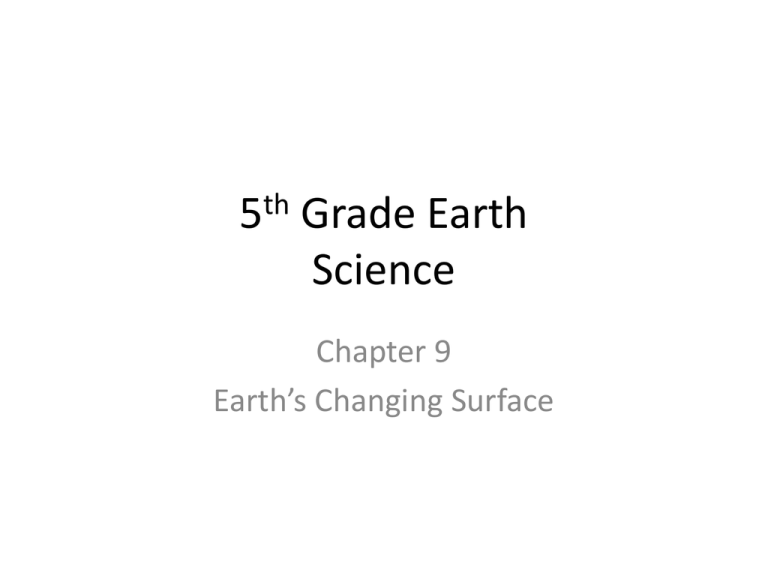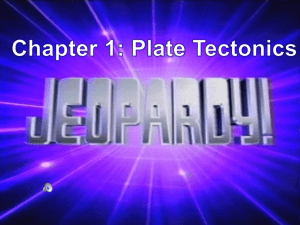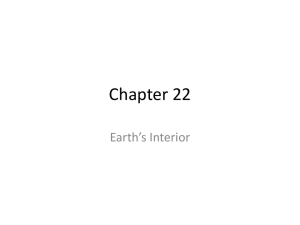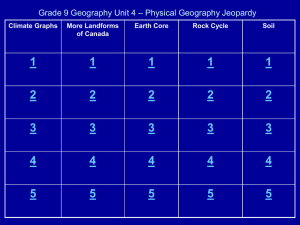5th Grade – chapter 9
advertisement

5th Grade Earth Science Chapter 9 Earth’s Changing Surface What is the Earth made of? • Landforms on Earth include: – – – – – Mountains __________ __________ - flat land Plateaus ________ Gorges - a deep crack Plains - flatlands with few trees ______ valleys - on land where mountains are close _______ together – ______ Ridges - beneath the ocean, long row of towering mountains – ________ Trenches - long narrow canyons in the ocean floor Earth’s Layers • The Earth is composed of three distinct layers: Crust 1. ______ - outermost solid layer of the Earth. - The part of the Earth where life is sustained This layer includes _____and _____ soil rock that covers the surface ocean and dry _______ land The crust is covered by _______ The thickness of the Earth’s crust varies Earth’s Crust The Mantle Mantle • 2. The _______ - is the layer of Earth just below the Earth’s crust. mass – This layer contains most of the Earth’s _______ the amount of matter in an object – The outer part of the mantle closes to the crust is solid _____ – The inner part of the mantle furthest from the crust is made of rock that is so hot that it can flow very slowly. _____ Structure of the Earth The Core core - the innermost layer of the • 3. The ____ Earth. The core is made primarily of ______. iron – This layer is most compact because of all of the weight above it – The core is divided into two distinct parts: • ___________ Outer core - located closest to the mantle. This layer is so hot that it is liquid Inner Core - located furthest from the mantle and • ___________ crust – this layer is solid Layers of the Earth Section Assessment • Page 265 questions 1-3 Earth’s Plates lithosphere • _________ - the Earth’s crust and the upper part of the mantle. – The lithosphere is not a continuous layer it is Tectonic plates made up of pieces called ______________. – The tectonic plates are of varying shapes and sizes but they all fit together like a puzzle. – Much of the Earth’s lithosphere is under ________ oceans and other bodies of water. 10 major tectonic plates – There are ____ Tectonic Plates Spreading Ocean Floor Mid-Atlantic Ridge - chain of mountains running • ____________ along the floor of the Atlantic ocean. Henry Hess • ____________ - A scientist in 1960 claimed that new crust forms at ocean ridges – this explains the existence of trenches and ridges. • ________ - molten rock, pushes upward from magma the Earth’s crust. As the magma cools it forms new crust. What causes Magma to rise? • As Earth plates move away from each other, the ocean floor spreads apart and new crust rises to fill the gaps. • What causes the plates to move apart? • __________ Arthur Holmes - 1930’s when a liquid is heated, particles speed up and move apart. – ___________ weigh less and float above Hot liquids Cooler liquids ____________. Convection • _________ convection - as the hot liquid rises and cools it becomes heavier again and sinks, more hot liquid can rise above again – transfer of thermal energy by the movement of a liquid or gas. mantle • Currents in the ________ constantly rise from the slow flow of the molten rock, circle around and then fall. • Convection is the force _______ that moves the Earth’s plates. Theory of Plate Tectonics Theory of Plate Tectonics - the _________ lithosphere is broken • ________________ into 20 moving plates. – Plates in constant motion and in different directions. – ____________________ Global Positioning System - (GPS) satellites in space - determine the distance between plates and their change over time. – This theory explains many of Earth’s features Moving Continents • Continents move apart • Mountains form where plates move together • As plates move apart, magma may rise to the volcano surface forming a ________ • Oceans may become larger or smaller • Positions of land and oceans has changed and continues to change from the time of Pangea _________ to the __________. Continents Plate Boundaries Plate Boundaries • _____________ - areas where two plates meet. Spreading boundaries - plates move away from – _________________ each other • gaps form between the plates • __________________ Convection currents cause magma to rise between the gaps • Huge valleys ________ form Mid-Atlantic Ridge • Sea floor spreading – ex. _____________________ Plate boundaries continued • ______________ Fracture boundaries - plates slide past each other • _____break in the Earth’s crust as a result of fault fracture boundaries – this can cause earthquakes _________. Colliding Boundaries - two plates push against • ______________ each other – one plate might slide underneath the other – towering mountains, deep ocean trenches, earthquakes, and volcanoes can result. Boundaries and GPS Earthquakes Earthquakes are caused by the sudden shifting • _________ of rock as tectonic plates shift positions – Pressure builds up, rocks lurch forward, and the Earth’s crust shakes. – ______ focus - the underground point where the earthquake occurs epicenter - point on the Earth’s surface directly – ________ above the focus. Waves • Energy from the earthquake is carried by _______. waves focus and • Waves spread out from the _____ ________. Volcanoes • Waves can cause the Earth to move ________, Up and down ___________, or in a ___________ Back and forth Circular motion • As the waves spread out from the epicenter, they __________. Lose energy Earthquakes and Plate boundaries California Alaska • ____________ and _________ have had the most earthquakes because they are located on Plate Boundary between the Pacific plate and a ____________ the North American Plate. • The strength of an earthquake can be measured on a ____________ Magnitude scale - a series of numbers that is based on the amount of energy that is released. S and P waves • http://www.thetech.org/exhibits/online/quak es/waves/p&s_waves.html Draw a diagram of each Volcanoes • __________ occur when magma from the Volcanoes mantle either flows or explodes through the crust. – Opening in the surface of the Earth through which magma rises – Occur near ______________ Plate boundaries – Theory of plate tectonics – one plate sinks beneath another at a plate boundary – sinking crust melts into _______. magma lava - Magma that reaches the surface – _____ Draw and Label Volcanoe page 270271 Earth’s Features • Earth’s surface is made up of many different __________. Landforms • Earth’s surface is constantly ________ and so changing are the landforms weathering • ___________ - the process of breaking down rock into smaller pieces • Forces of __________ include ________ and weathering water _____ ice Mechanical / Chemical Weathering • _________________ - process of breaking Mechanical Weathering down rock into smaller pieces as a result of ice or water – MINERALS THAT MAKE UP THE ROCK DO NOT CHANGE! • ________________ - minerals that make up Chemical Weathering the rock change. • The cause of chemical weathering is a _________ with something in the reaction water or ________ oxygen environment such as ____ Erosion erosion • ________ - the process by which soil and sediments are transferred from one location to another • The movement of soil and sediments can be caused by: – _________ wind – ________ water – ______ ice – ________ gravity Soil Erosion • Areas of land with no plant covering are Soil erosion susceptible to __________ • __________ - help prevent soil erosion by Plant roots holding the soil in place Cover crops • ___________ - planted by farmers in between harvests to prevent soil erosion and add nutrients to the soil • ______________ Dust Bowl of 1930’s - years of drought and poor farming practices left bare areas of soil Soil soil - made of weathered rock, air, water, and • ____ the remains of living things. weathering • __________ - process of breaking down rocks through physical factors such as _____, frost drought rainwater or__________________. Changes in temperature _________, _______ • ________ = non-living parts of the soil inorganic • As rock breaks down small pieces collect on the surface Soil Formation • _______ and _______ are plants that help mosses lichens break down rock. • When rocks are broken down minerals _______are released • ___________ - dead or decaying matter such Organic matter as bacteria, fungi, animals and plants. humus • ______ - dark colored organic matter formed from decayed plant and animal Rich in nutrients needed by plants remains- _______________________ Layers of Soil • Soils form in _____ three layers • _________a vertical cross section of the soil Soil profile and rock underneath • ________ - first layer of soil, mixture of small topsoil rock pieces, humus, and other organic matter – Most living things are found in the _______ topsoil – Loose _____________ Organic matter often covers the topsoil – Rainwater carries minerals from the topsoil to the 2nd layer of soil. Subsoil / Parent Rock Layers subsoil • _______ - less organic matter than topsoil, lighter in color. mineral • _________ penetrate the subsoil through rainwater and accumulate Parent rock - third layer, very little organic • _________ matter found in this layer Water • _________ - solid particles that are moved from sediments one place to another deposition __________ - sediments that form during weathering and erosion are deposited in another location During the process of deposition, the _______ and shape direction of a river’s flow changes ________ As rivers flow to the oceans they carry ________ sediments Dissolved minerals which are useful to plants and ______________ and animals to carry out their __________ Life processes River Systems Dynamic systems • Rivers and streams are _____________ always moving and changing • _______ Stream - begins on land that is higher than sea level – ______ gravity pulls the water downward to a lower area • _____ river - streams join until a river is formed • River water wears down soil and rock and carries their ________ sediments away in different places Wave Energy Pass along • Ocean waves ________ and __________ a carry great deal of _________ energy • Water _______ and _______ in a circular rises falls motion • __________ contained in the waves moves energy forward • _________________ Shallower ocean bottom interferes with the waves movements – causes waves to slow Waves continued • Wind Waves are formed when energy is transferred from the ________ to the _______ wind water • ____________ depends on the _________ Size of waves Wind speed and how __________ Long it blows and _____________ Distance it covers • Waves can also be caused by: – ______________ tectonic activity Volcanic eruptions – _______________ – ______________________ Earthquakes and landslides Dynamic Systems • __________ are dynamic systems because the beaches energy from waves has the power to • _________ also build up beaches by moving waves sand along the shore sandbar • _________ created when waves move materials from the shoreline to an area away from the shore • __________ - places where water bodies are lagoons separated from the open ocean Beaches • ________ formed when wind carries sand dunes along the shore - sand builds up into small hills • ______________are constantly changing as a Coastal Landforms result of wind ________ and ______ water • _____ of any beach is Color and ________ texture sand determined by the sources of its ______ and _____ - no two beaches are the same! rock Section Assessment • Question 1 on page 278 Section Assessment • Questions 1-3 page 281 Minerals • ___________ - a natural, non-living solid with Mineral a definite chemical structure. 4,000 kinds • Earth’s crust contains more than _________ minerals – only two dozen are common. • Examples: diamond, quartz, emerald copper crystals • Minerals are made up of ______. • Particles of _______ are arranged in a crystals particular repeating pattern. Crystals Mineral • _______ form when minerals are made in nature • Each type of mineral has its own unique chemical __________. structure • Differences in minerals result from the way that particles are arranged. • Brass – Copper + Zinc –____________because Not a mineral it does not occur naturally Identifying Minerals characteristics • Minerals are identified by their ____________ • _______________ Moh’s hardness scale - a scale to measure hardness of a mineral • The range of the harness scale is from 1 Softest Hardest (_______) to 10 (______) 1 / diamond is a _____ 10 • Talc has a harness of __ • ________ - refers to how difficult it is to hardness scratch its surface Other Mineral Characteristics • _______ - a mineral may have different Color crystals depending on the kinds of materials crystals that make up its ______. • The color of a mineral can be seen in its ______. streak • A mineral can also be identified by the ______ shape of its crystals. • _______ Cleavage - minerals show particular patterns when they are broken along flat planes. Luster • ______ Luster - the appearance of a mineral in reflected light. • A mineral may appear: Metallic – __________ – __________ Nonmetallic Greasy – __________ Glassy – __________ Waxy – __________ Rocks • _____ - a solid, natural material made up of rock one or more minerals Rock cycle • ___________ - as time passes, rock break down, and the minerals in them are recycled – pattern of change • The rock cycle takes place over millions ________ of years. • There are three types of rocks: __________, sedimentary __________, and __________ igneous metamorphic Sedimentary Rock • ______________ - made from pieces of rocks Sedimentary rock and minerals layers • Sedimentary rock forms in ________ - the oldest rock at the bottom and the newest rock on top. • Sedimentary rock is like a “_________” - past History book events captured in each layer. • _____ fossils - remains of once living animals or plants Sedimentary Rock Continued Sedimentary rock • Fossils are ONLY found in _____________ • Example of sedimentary rock = ________ limestone • Limestone is made from _________________ Shells of tiny sea animals or from dissolved __________ that settle out minerals of seawater. Igneous Rock • __________ Igneous rock - forms from magma – molten rock inside of the earth that cools and hardens Earth’s surface • Some igneous rock forms Below ______________ and is only exposed after rocks above have worn away • Other igneous rocks form when lava _____ cools at the Earth’s surface • When lava cools fast - _______________ Fine-ground rocks form • When lava cools slowly - _______________ Coarse-grained rock Metamorphic Rock Metamorphic rock - forms when heat, pressure, • _____________ or chemical reactions change one type of rock into another type of rock. • Metamorphic rock is made from ___________ Sedimentary rock Igneous rock or _________. • Example: ______ marble is a metamorphic rock made limestone (sedimentary rock) from________ Compare and Contrast • How are the three types of rocks similar and different? Clues to the Past • Scientists can tell a great deal about Earth’s history by looking at _____. rocks Relative dating • ______________ - scientists look at the layers of sedimentary rock and learn about the relative age of each layer and the minerals found in it. • Relative dating allows scientists to place past events in ____________ Sequential order Rock Cycle









